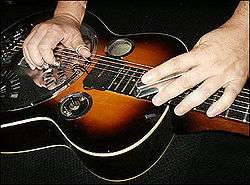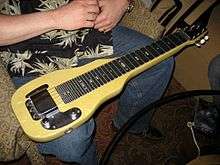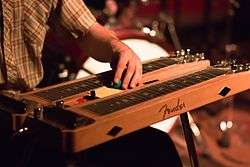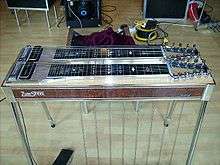Steel guitar
A steel guitar is any type of guitar that is played by pressing and moving a hard object against the strings that allows the player to make an infinite smooth glissando or deep vibrato that is not possible with the fingers alone. The hard object was historically called a "steel" and this is the origin of the name "steel guitar". It may be a solid bar held in the hand or a tubular object placed around the player's finger; it may go by many names, including "steel", "tone bar", "slide", "bottleneck" and others. The strings are typically plucked (not strummed) by the fingers of the dominant hand while the tone bar is pressed against the strings and moved by the opposite hand. Creating music with a slide of some type has been traced back to primitive stringed instruments in African culture.

A steel guitar might be or look like an ordinary guitar and be played in the traditional position (flat against the body). In that case, the player uses a tubular object around his finger, then called a "slide", and the technique is called "slide guitar" and is typically heard in blues or rock music. The term "bottleneck" was historically used to describe this type of playing.
A steel guitar may also be played in a horizontal position, a technique popularized in Hawaii in the 1890s by Joseph Kekuku, with the instrument placed across the knees or otherwise supported. In this case, the hard object would be a solid bar held in the hand (see photo) and called a "steel" or "tone bar" and that type of playing referred to as "lap style" or "Hawaiian style".
From its first use in Hawaii in the 19th century, the sound of a steel guitar became popular in the United States in the first half of the 20th century and spawned a family of instruments designed specifically to be played with the guitar in a horizontal position. The first instrument in this chronology was the Hawaiian guitar also called a lap steel; next was a lap steel with a resonator to make it louder. In 1934, the electric guitar pickup was invented , allowing steel guitars to be heard equally with other instruments. The invention also allowed new guitars to be designed without any resonant chamber, bearing no resemblance to the traditional guitar shape, e.g., a rectangular block. Electronic amplification led to the development of the electrified lap steel, then the console steel, and the pedal steel guitar.
Definitions of steel guitar
A steel guitar is any guitar played with a hard object against the strings with one hand to change pitch while the strings are plucked with the opposite hand, typically one of two general types:
- A guitar held in the traditional position (flat against the body)and played with a hard object against the strings by the supinated hand, while plucking the strings with the opposite hand, such as:
 Slide guitar played with slide on musician's little finger
Slide guitar played with slide on musician's little finger- An acoustic or electric guitar played with a tubular slide on the finger, a style called "slide guitar"
- A round-necked resonator guitar played with a tubular slide.
* A guitar designed to be played horizontally (called a Lap steel guitar),

typically played with the hand pronated holding a solid bar, while plucking the strings with the opposite hand:
- a traditional guitar adapted for horizontal playing by raising the nut and the bridge to make the strings higher off the fretboard
- An acoustic Hawaiian guitar
- An electric lap steel guitar (see photo)
- A resonator guitar such as a National or Dobro-type guitar with a reinforced square neck
- An electric console steel guitar in a frame with legs, typically with more than one neck.
- An electric pedal steel guitar, a console steel with pedals and knee levers to increase versatility
Lap slide guitar is not a specific instrument, but a style of playing.[1]
Early history and evolution
The instrument's ancestry is traced to the Hawaiian Islands in the late 19th century after the Spanish guitar was introduced there by European sailors[2] and by Mexican vaqueros who came there to herd cattle.[3] Hawaiians who perhaps did not want to take the time to learn how to play a Spanish guitar re-tuned the instrument so it sounded a major chord when strummed, then thought to be an "unorthodox tuning".[3] This was known as "slack-key" because some of the strings were "slackened" to an open tuning.[2] To change chords, they used some smooth object, usually a piece of pipe or metal, sliding it over the strings to the fourth or fifth position, easily playing a three-chord song.[lower-alpha 1] To play using a steel bar, early players laid the guitar across the lap and played it while sitting. The problem with playing a traditional Spanish guitar this way was that the steel tone bar strikes against the frets making an unpleasant sound unless played very lightly—this was corrected by raising the strings higher off the fretboard with a piece of metal or wood over the nut.[2] This technique became popular throughout Hawaii.[2]
Joseph Kekuku was a Hawaiian from Oahu who became proficient in this style of playing around the end of the 19th century and popularized it—some sources say he invented the steel guitar.[5] He moved to the United States mainland and became a vaudeville performer and also toured Europe performing Hawaiian music.
The Hawaiian style of playing spread to the United States mainland and became popular during the first half of the 20th century; noted players of the day were Frank Ferera, Sol Hoʻopiʻi, Sam Ku West and "King" Bennie Nawahi. This music became popular to the degree that it was called the "Hawaiian craze" and was ignited by several events.[6]
One such event was a 1912 Broadway musical show called Bird of Paradise, which featured Hawaiian music and elaborate costumes.[7] The show became a hit and, to ride this wave of success, it was subsequently taken on the road in the U.S. and Europe, eventually spawning a motion picture of the same name.[6] Joseph Kekuku was a member of the show's original cast [8] and toured Europe with the Bird of Paradise show for eight years.[9] The Washington Herald in 1918 stated, "So great is the popularity of Hawaiian music in this country that 'The Bird of Paradise' will go on record as having created the greatest musical fad this country has ever known".[10]
Another event fueling the popularity of Hawaiian music was a radio broadcast called "Hawaii Calls" which began broadcasting from Hawaii to the US west coast. It prominently featured the steel guitar and Hawaiian songs sung in English. Subsequently, the program was heard worldwide on over 750 stations.[11] One of steel guitar's foremost virtuosos, Buddy Emmons at age 11 trained at the "Hawaiian Conservatory of Music" in South Bend, Indiana.[12]
The acceptance of the sound of the steel guitar, then referred to as "Hawaiian guitars" or "lap steels", spurred instrument makers to produce them in quantity and create innovations in the design to accommodate this style of playing.[13][14]
Steel guitar playing divides into two different directions
In the early twentieth century, steel guitar playing divided into two streams: bottleneck-style, performed on a traditional Spanish guitar held flat against the body; and lap-style, performed on an instrument specifically designed or modified for the purpose of being played on the performer's lap.[15] The bottleneck-style became associated with blues guitar, and the horizontal style became associated with American country music.
Steel guitar in Blues music
One of the first southern blues musicians to adapt the Hawaiian sound to the blues was "Tampa Red"[16] whose playing, says historian Gérard Herzhaft, "created a style that has unquestionably influenced all modern blues."[16] The bottleneck-style was popularized by African-American blues artists.[15] The Mississippi Delta was the home of Robert Johnson, Son House, Charlie Patton, and other blues pioneers, who prominently used a tubular slide on a finger.[17][18] The first known recording of the bottleneck style was in 1923 by Sylvester Weaver, who recorded two instrumentals, "Guitar Blues" and "Guitar Rag".[19][20] His song, "Guitar Rag", was adapted by Western swing pioneers Bob Wills and Leon McAuliffe in 1935 for the influential instrumental "Steel Guitar Rag".[21] Blues musicians played a conventional Spanish guitar as hybrid between the two types of guitars, using one finger inserted into a tubular slide or a bottleneck while using frets with the remaining fingers.[2] This is known as "slide guitar" and the hard object against the strings in this case is called a "slide".
Steel guitar in country music
Steel guitar was heard in American country music as early as the 1920s. Jimmie Rodgers featured acoustic steel guitar in his song "Tuck Away My Lonesome Blues" (1929). Acoustic lap steel guitars were not loud enough to compete with other instruments, a problem that many inventors were trying to remedy in the early 1930s. A violin repairman in Los Angeles named John Dopyera and his brother Rudy created creating a guitar with a large resonator cone (resembling a loudspeaker) attached under the instrument's bridge.[22] Their company was called Dobro, a portmanteau of DOpyera BROthers. A former associate of the Dopyeras, George Beauchamp went on his own to invent an electric guitar pickup. Beauchamp came up with the idea of using two horseshoe magnets encircling the guitar strings like a bracelet, and six small metal rods wrapped with wire to concentrate the magnetic field (one under each guitar string).[23] A vibrating metal string in a magnetic field generates a small current that can be amplified and sent to a loudspeaker. He applied for patent June 2, 1934 and received it on August 10, 1937.[23] According to music writer Michael Ross, the first electrified stringed instrument on a commercial recording was a western swing tune by Bob Dunn in 1935.[24] He recorded with Milton Brown and his Musical Brownies. Brown has been called "The father of western swing"[25]
In the mid- to late-1930s, Leon McAuliffe advanced steel guitar technique while playing in the western swing band Bob Wills. McAuliffe's "Steel Guitar Rag" helped to popularize the steel guitar in the context of 1930s and 1940s country and western music. By the late 1940s and early 1950s, the steel guitar was prominently featured in the emerging "honky-tonk" style of country music. Honky-tonk singers who used a lap steel guitar in their musical arrangements included Hank Williams, Lefty Frizzell and Webb Pierce. The need was there to change tunings and keys, so steel players added additional necks on the same instrument. The added bulk and weight made the instrument so heavy that it could no longer be held on the player's lap and had to be placed in a frame with legs. This was called a console steel guitar, which contained as many as four different necks. Since these instruments proved too expensive for most musicians, a better solution was needed, which led to the invention of the pedal steel guitar.
A pedal system was designed about 1948 by Paul Bigsby, a motorcycle shop foreman.[26] Bigsby put pedals on a rack between the two front legs of the steel guitar. The pedals operated a mechanical linkage to apply tension to raise the pitch of the strings.[27] In 1953, musician Bud Isaacs used Bigsby's invention to change the pitch of two of its strings, and was the first to push the pedal while notes were still sounding. When Isaacs first used the setup on the 1956 recording of Webb Pierce's song "Slowly", he pushed the pedal while playing a chord, so certain notes could be heard bending up from below into the existing chord to harmonize with the other strings, creating a stunning effect which had not been possible with the steel bar. It was the birth of a new sound in country music and caused a virtual revolution among steel players who wanted to duplicate it.[28][26]
Steel guitar in other genres
Steel guitar has been incorporated into songs and compositions across many genres of music. In the late 1920s jazz musician Andy Sanella, although primarily a saxophonist had some success as a steel guitarist and recorded several solo records of steel guitar music with a jazz flavor. South African banjoist and guitarist, Len Fillis also played the instrument in jazz and dance bands in London in the early 1930s. Steel guitar has been featured in swing music (e.g., the work of bandleader Alvino Rey), rock (e.g., Steely Dan's "Razor Boy", and Beck's "Sissyneck"), soul (e.g., The Spinners' "Sadie"), reggae (e.g., Toots & The Maytals' "Beautiful Woman"), jazz (e.g., Bill Frisell's Blues Dream album), Indian classical music (e.g., the music of guitarist Shrikrishan Sharma), gospel music (particularly in the sacred steel tradition), and in many other genres of music.
The steel guitar's popularity in India began with a Hawaiian immigrant who settled in Calcutta in the 1940s named Tau Moe (pronounced mo-ay). Moe taught Hawaiian guitar style and made steel guitars, and is believed to have been a force in popularizing the instrument in India.[29] By the 1960s, the steel had become a common instrument in Indian popular music—later included in film sound tracks. Indian musicians typically play the lap steel while sitting on the floor and have modified the instrument by using, for example, three melody strings (played with steel bar and finger picks), four plucked drone strings, and 12 sympathetic strings to buzz like a sitar.[30] Performing in this manner, the Indian musician Brij Bhushan Kabra adapted the steel guitar to play ragas, traditional Indian compositions and is called the father of the genre of Hindustani Slide Guitar.[29]
Technique
Steel guitar may be played with the guitar held horizontally, with the bass strings towards the player, and using a device called a "steel" against the strings above the fingerboard rather than fretting the strings with the fingers. If a traditional guitar is played this way, the steel may hit against the frets causing an unpleasant sound. This is usually remedied by raising the strings higher off the fretboard using a nut extender, because frets are not used in lap steel. When strings are raised like this, it may create a much greater force on the neck than a traditional guitar can take; these instruments are usually designed with thicker (sometimes square) reinforced necks or are used in console instruments in a rectangular frame.
Instruments designed and produced for horizontal playing typically have painted lines or "pictures of frets" as a visual cue only. Without frets, playing in tune is more difficult and requires considerable skill to place the bar exactly where the fret would be. Another obstacle to overcome is the fact that when a note is sounded or a steel guitar, it continues to sound until it dies out. On a piano, by contrast, a note stops as soon as the player's finger is lifted off the key. A steel guitarist must play the note and physically stop it afterward. This is called "blocking" and may be done by the players palm (palm-blocking) another digit (pick-blocking). Using the piano analogy, playing steel without blocking or damping would be like playing a piano with the sustain pedal permanently depressed— the notes would overlap and staccato passages would not be possible.
On non-pedal steel guitars, the bar may be slanted at an angle when playing to change an interval between two or more notes played simultaneously on different strings. On a pedal steel guitar, slanting the bar is rarely needed.
Dobro is a brand of resonator guitars, but the word is commonly used as a generic term to describe bluegrass resonator lap steels of any brand. Tunings and techniques are similar to acoustic Hawaiian steel guitar playing, but have evolved somewhat differently in the bluegrass idiom, which may use a steel bar with a deep groove in it (see photo above) to allow the steel to be grasped more firmly and to be lifted and pointed downward for pull-off notes.
Slide guitar is similar, with the exception that the guitar is held in the conventional position, and a different, tubular form of slide is slipped over the middle, ring or little fingers to accommodate this playing position. The slide is almost never slanted. Slide guitar may be played as a hybrid by fingering the frets on some strings (usually for rhythm accompaniment) and using the slide on others. Slide players may use open tunings or traditional tunings as a matter of personal preference.
Lap steel guitars
Early lap steel guitars were Spanish guitars modified by raising both the bridge and head nut. The string height at the head nut was raised to about half an inch by using a head nut converter or converter nut. This type of guitar is claimed to have been invented in about 1889 by Joseph Kekuku in Hawaii.[31]
The Rickenbacker frying pan, an electric lap steel guitar produced from 1931 to 1939, was the first commercially successful solid body electric guitar.
Console steel guitars
The console steel guitar is an electric instrument, intermediate between the lap steel from which it developed and the pedal steel which in turn developed from the console steel. There are no pedals, so the player has only as many tunings available as there are necks.
The development of the lap steel guitar into the console steel guitar saw the introduction of amplification as standard, multiple necks, and additional strings on each neck, first to seven, and eight strings per neck is now common. One, two, three and four neck instruments are not uncommon. The two neck, eight string per neck configuration is particularly favored in Hawaiian music.
The distinction between console steel guitar and lap steel guitar is fuzzy at best, and some makers and authorities do not use the term console steel guitar at all, but refer to any steel guitar without pedals as a lap steel guitar even if playing it in lap steel position would be quite impossible.
Pedal steel guitars
The pedal steel guitar is an electric instrument normally with eight to fourteen strings per neck, and one or two necks, each in a different tuning, usually C6 and E9. It may have up to ten pedals (not counting the volume pedal) and up to eight knee-levers are used to alter the tunings of different strings, which gives the instrument its distinctive voice, most often heard in country music.
The extra strings and use of pedals gives a pedal steel guitar far more versatility than any other type of steel guitar, but at the same time makes playing far more complex.
Steels
A steel is a hard object pressed agains the strings and is the reason for the name "steel guitar". It may go by many names, including "steel", "tone bar", "slide", "bottleneck" and others. A cylindrical-shaped steel with a bullet-shape on one end is typical in console steel and pedal steel playing. Lap steel and Dobro players often use a steel bar with squared-off ends and a deep groove for firmer grip. It has a cross section that resembles a railroad track.
See also
Notes
- The Hawaiians also learned to play this re-tuned guitar without a steel, fretting it and holding it against the body like a traditional guitar. This led to its own genre known as slack-key guitar.[4]
References
- Tipaldi, Art (2002). Children of the Blues: 49 Musicians Shaping a New Blues Tradition. Hal Leonard.CS1 maint: ref=harv (link)
- Ross, Michael (February 17, 2015). "Pedal to the Metal: A Short History of the Pedal Steel Guitar". Premier Guitar Magazine. Retrieved September 1, 2017.
- Fox, Margalit (March 5, 2008). "Ray Kane, Master of Slack-Key Guitar, Dies at 82". The New York Times. Retrieved December 11, 2017.
- Peterson, Jeff. "Jeff Peterson Demonstrates Slack Key Guitar". jeffpetersonguitar.com. YouTube. Retrieved May 10, 2020.
- "History of the Hawaiian Steel Guitar". Hawaiian Steel Guitar Association. Archived from the original on 29 July 2010. Retrieved 21 May 2010.
- Duchossoir, A.R. (2009). Gibson electric steel guitars : 1935–1967. Milwaukee, WI: Hal Leonard. p. 8. ISBN 978-1-4234-5702-2.
- Ruymar, Lorene (1996). "The Hawaiian Steel Guitar and Its Great Hawaiian Musicians". Centerstream Publications. p. 31.
- "Hawaiian Music to be Feature of Big Chautauqua Program". The Colville Examiner (No. 456). Colville, WA. July 22, 1916. p. 6. Retrieved December 10, 2017.
- "Polynesian Cultural Center Unveils Statue of Joseph Keku, Inventor of the Hawaiian Steel Guitar". polynesia.com. Polynesian Cultural Center. 2015. Retrieved December 9, 2017.
- "Bird of Paradise Brought Hawaiian Music Fad East". The Washington Herald (No. 4188). April 14, 1918. p. 1. Retrieved December 9, 2017.
- Ruymar, Lorene (1996). "The Hawaiian Steel Guitar and Its Great Hawaiian Musicians/Hawaii Calls". Centerstream. p. 46. ISBN 978-1-57424-021-4.
- Betts, Stephen L. (July 30, 2015). "Steel Guitar Great Buddy Emmons Dies". Rolling Stone. Wenner Media. ISSN 0035-791X. OCLC 693532152. Retrieved 20 January 2017.
- "Early History of the Steel Guitar". steelguitaracademy.com. Steel Guitar Academy. Retrieved 1 September 2017.
- Tom Noe. "Herman Weissenborn". Weissenborn → History. Retrieved September 1, 2017.
- Volk, Andy (2003). Lap Steel Guitar. Anaheim, California: Centerstream Publications. p. 9. ISBN 1-57424-134-6.
- Herzhaft, Gérard (1996). Encyclopedia of the Blues (5. Dr. ed.). Fayetteville, AR: University of Arkansas Press. pp. 334–335. ISBN 978-1-55728-252-1.
- Sokolow, Fred (2011). Slide Guitar for the Rock Guitarist. Pacific, Missouri: Mel Bay. p. 3. ISBN 978-1-61065-563-7. Retrieved June 21, 2020.
- Erlewine, Michael (1996). All Music Guide to the Blues (Encyclopedia Articles). San Francisco: Miller Freeman. p. 372. ISBN 0-87930-424-3. Retrieved June 21, 2020.
- Russell, Tony (1997). The Blues: From Robert Johnson to Robert Cray. Dubai: Carlton Books. p. 12. ISBN 1-85868-255-X.
- Fetherhoff, Bob (2014). The Guitar Story: From Ancient to Modern Times. BookBaby. p. ebook. ISBN 978-1-4835-1683-7. Retrieved June 21, 2020.
- Mann, Woody (1979). Bottleneck Blues Guitar. London: Oak Publications. p. ebook. ISBN 978-1783235261.
- Drozdowski, Ted (December 18, 2012). "How Resonator Guitars Work and Sound So Cool". gibson.com. Gibson Brands. Archived from the original on November 19, 2015. Retrieved September 6, 2017.
- "First-ever electric guitar patent awarded to the Electro String Corporation". history.com. A&E Television Networks. Retrieved September 20, 2017.
- Foley, Hugh W., Jr. "Dunn, Robert Lee (1908–1971)". Encyclopedia of Oklahoma History & Culture. Oklahoma Historical Society. Archived from the original on September 5, 2008. Retrieved May 8, 2020.
- Ginell, Cary (1994). Milton Brown and the Founding of Western Swing. Urbana, IL: Univ. of Illinois Press. ISBN 0-252-02041-3.
- Winston, Winnie; Keith, Bill (1975). Pedal steel guitar. New York: Oak Publications. p. 116. ISBN 978-0-8256-0169-9.
- Ross, Michael (November 17, 2011). "Forgotten Heroes: Paul Bigsby". Premier Guitar Magazine. Retrieved September 11, 2017.
- Brenner, Patrick. "Early History of the Steel Guitar". steelguitaramerica.com. Patrick Brenner. Retrieved June 29, 2017.
- Ellis, Andy (June 8, 2012). "The Secret World of Hindustani Slide". Premier Guitar Magazine. Retrieved September 17, 2017.
- Bhatt, Vishwa Mohan (August 28, 2011). ""Raag Kirwani"(song)". youtube.com. YouTube. Retrieved September 15, 2017.
- "Archived copy". Archived from the original on 2017-04-22. Retrieved 2010-08-25.CS1 maint: archived copy as title (link)
External links
- Steel Guitar Forum A forum where steel players and enthusiasts get together and discuss steel guitar.
- Hawaiian Steel Guitar Association An organization which promotes the development of steel guitar with worldwide membership.
- A example of slide guitarist using the frets for rhythm while using the slide

